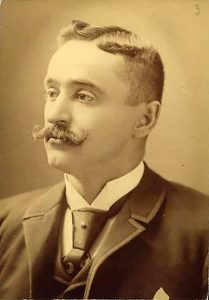Long bef ore our Baltimore Orioles were led to success by the fiery Earl Weaver, there once was a champion baseball club in Baltimore in the 1890s. This club was also called the Baltimore Orioles, and they were led by Edward “Ned” Hanlon, a long-time resident of Bolton Hill and Baltimore’s first great baseball manager.
ore our Baltimore Orioles were led to success by the fiery Earl Weaver, there once was a champion baseball club in Baltimore in the 1890s. This club was also called the Baltimore Orioles, and they were led by Edward “Ned” Hanlon, a long-time resident of Bolton Hill and Baltimore’s first great baseball manager.
Hanlon was born in 1857 in Montville, CT and he was playing for the Cleveland Blues in 1880, only four years after the National League was founded. In 1881 he began a successful eight-year run with the Detroit Wolverines, and he had his best statistical season with them in 1887 as captain of a team that won a championship series. During a 13-year career as a player, he rapped out 1,318 hits, but he was best known as an excellent defensive centerfielder and a speedy base runner.
In 1888-89 Hanlon was selected as a player in Albert Spalding’s “Around the World Baseball Tour” which promoted the game in such destinations as Hawaii, Australia, Egypt, Ceylon, France, and Britain. The group was welcomed home with a banquet at Delmonico’s in New York City attended by Theodore Roosevelt and Mark Twain.
Harry von der Horst, owner of the Orioles and son of a prominent local brewery owner, hired Hanlon in 1892 to manage the team. Hanlon bought an elegant corner row home at 1401 Mt. Royal, a spot now occupied by MICA’s Bunting Building, where he and his wife Helen and their five children lived for over 30 years.
Hanlon was given stock in the team and full authority over baseball operations, and he immediately made shrewd player moves that transformed a last-place team into one of the greatest teams in baseball history, gaining him the nickname “Foxy Ned.” He assembled a core of feisty players which included future Hall of Famers, and he developed a “scientific baseball” approach. That approach made frequent use of the hit-and-run, the double steal, the suicide squeeze, and the “Baltimore Chop.” Hanlon’s Orioles intimidated and out-smarted other teams, winning three straight NL pennants (1894-1896) and producing a style of play that was imitated by many teams.
After the 1898 season, Hanlon moved on to manage the Brooklyn Superbas (later the Dodgers) for seven years while winning two pennants. He also had short stints with the Pittsburgh Pirates and Cincinnati Reds and won 1,313 games and five pennants during his 19-year managerial career.
After leaving his baseball life behind him, he joined the Baltimore Parks Board in 1916, becoming its president in 1931. Tragically, his son Lt. Joseph T. Hanlon was killed in World near War I. Ashburton Park in northwest Baltimore was renamed Hanlon Parkin 1920 to honor his memory.
On April 14, 1937, Ned Hanlon died at age 79 at the home of one his daughters near the Roland Park Library. His funeral service was held at Corpus Christi Church, attended by many notables from the baseball world. Testimonials poured in. Hall of Famer Connie Mack, an honorary pallbearer at his funeral, remarked that Hanlon was “the greatest leader baseball ever had . . . and I don’t believe any man lived who knew as much baseball as he did.” Sporting News added that he was the “game’s greatest strategist” and “the Father of Modern Baseball.”
Foxy Ned was laid to rest in Baltimore’s New Cathedral Cemetery where three of his famous Hall of Fame players from the old Orioles are also buried: John McGraw, Wilbert Robinson, and Joe Kelley. No other cemetery has as many Hall of Famers. Ned Hanlon was finally elected to the Hall of Fame in 1996 in the same class as another Orioles managerial great — Earl Weaver.
– Tom Delise
